
Page 34
http://threesology.org
Note: the contents of this page as well as those which precede and follow, must be read as a continuation and/or overlap in order that the continuity about a relationship to/with the typical dichotomous assignment of Artificial Intelligence (such as the usage of zeros and ones used in computer programming) as well as the dichotomous arrangement of the idea that one could possibly talk seriously about peace from a different perspective... will not be lost (such as war being frequently used to describe an absence of peace and vice-versa). However, if your mind is prone to being distracted by timed or untimed commercialization (such as that seen in various types of American-based television, radio, news media and magazine publishing... not to mention the average classroom which carries over into the everyday workplace), you may be unable to sustain prolonged exposures to divergent ideas about a singular topic without becoming confused, unless the information is provided in a very simplistic manner.
Whereas we sometimes played games in childhood which utilized a binary "shirts" and "skins" demarcation of sides in a game (where one side wears their shifts and the other goes without); this same binary form of thinking exhibits itself in politics and how the government treats the citizenry. Governments create divisions because its employees have a frame of thinking that is particularly two-patterned oriented... and sometimes cohesively focused when it commits atrocities. And although a government like the U.S. may espouse a trinary three-branched system, this typically degrades to a binary or even a singularity... while the people are left out of the so-called (binary) checks-and balances provision. The people are subjected to one government policy after another that exhibits a binary treatment system... like a medical unit at a disaster scene that utilizes a three-based "triage" formula for dispensing medical aid... the government unknowingly, but frequently... relies on a "biage" formula of governance that may be rendered as a "means testing" program... to supposedly ensure those most in need get assistance, but those less than a certain need level are cut off.
This is the (U.S.) government:
|
(O)... From party politics were two distinctions are permitted to gain the same platform of contestation (though a third may be given media lip service)... and though multiple parties may exist... (1)... To election campaigns and subsequent ordering of Legislative and Executive tit for tats; a binary situation arises, though trinary configurations of thought are available for consideration, yet— like the Referendum, are rarely utilized. |
Even if one were to come up with a commercially viable trinary (ternary) computer system, those with a preferential two-patterned focus would try to increase and solidify their binary positions more concretely... by any means necessary. The present U.S. government for example, is run by a poorly crafted binary code that wants to make itself appear progressive by promoting the idea of a binary checks-and-balances formula applied to a trinary three-branched system; while it actually runs on a system with poor (historically applied) memory and a Constitution- wielding Supreme Court hard-drive that is corrupted beyond any effort to run a defrag program... and too many users of the government program overlook, ignore, can't see, or excuse the mistakes being made over and over and over again that the would prefer to live with and make excuses for because they fear the costs of getting a new (dynamic) system.
The reason for pointing out discrepancies in the government and political processes is to denote a bias that may be incorporated in the base programming of an AI system if its development is paid for by way of government funding... funding that should thus be defined as belonging to the people, but is used as the excuse for one or more politicians to infect a system with their prejudices. It is necessary to consider what sorts of patterns we want an AI system to perceive and catalog... particularly if a non-organic model is sent into space to gather information. Then again, the trip to and from may take so many generations that the programs used by those in the past might not have any functionality or applicability for those in the future. A dominant binary perspective may be laughed at by a population whose cognitive dominance is a trinary, or three-to-one ratio. It is of need for us to take into account the disintegration of the environment as the Earth, Sun, Solar system and galaxy heads towards a demise to which human biology has to adapt to.
It is of developmental and evolutionary relevance to think of both developmental biology and extent life forms in terms of their appearance during the differences in the Earth's rotation rate, the amount of available oxygen, and the intensity of the Sun's radiation since the Earth's inception in the developed solar system. While details in many respects are difficult to come by except through educated guesstimation, the patterns which prevailed no doubt had an influence on life and its subsequent changes by way of adaptation within a given species' "biological processing" of events taking place. A dominant two-patterned influence on an environmental level would no doubt affect biology in this regard. This may be the reason for so many examples of the male/female divisioning. Not only does this exhibit a binary formula, but also differences at each polar end which overlap in structure in some regard. (Men and women share some similar characteristics, thus indicating they were subjected to similar developmental influences.)
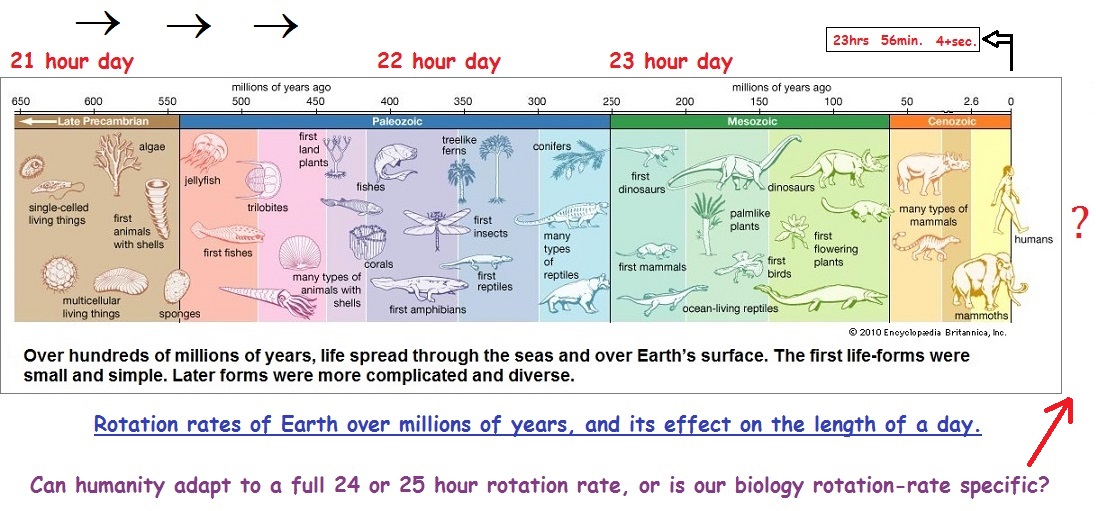
Organisms which utilize a binary development and subsequent orientation are simple-minded. Despite the ability of humans to participate in the construction of categories with a triple formula, an underlying binary plan without an ability to grow beyond itself— will be a burden to itself... an obstacle to achieving a higher functionality of self and not just a sense of self having achieved something beyond its grasp. Creating three-patterned religions and philosophies may be self-fulfilling, they nonetheless act as tethers to a binary foundation. Whereas some readers might construct a dot-to-dot scenario as thus: From Earth's third position→ to a triplet coding genetic system→ to three life domains→ to three Germ layers; and even though underlying primitive two and one-patterned constructions may not be easily visible... this is not to say that future development will begin at the third position by way of foregoing parts one and two. It may be that the patterns of the environment force the retention of two of the preceding steps because the environment retains this primitive pattern that life must in some fashion or another replicate according to the programming requirements of present biology.
Here is a catalogue listing of the three Germ layer physical dimensions which repeat each time a human is born. There does not appear to be a program developed for spontaneous generation of all three germ layer components at once, much less a spontaneous generation of life itself:
| Derivatives of primary germ layers Encyclopædia Britannica Article |
| Ectoderm |
| epidermis |
| cutaneous derivatives |
| epithelium of: mouth; oral glands nasal passages sense passages |
| central nervous system |
| peripheral nervous system |
| hypophysis; suprarenal medulla |
| Mesoderm |
| epithelium of: circulatory system spleen; lymph nodes urogenital system body cavities |
| connective tissues; blood; bone marrow |
| muscular tissues |
| skeletal tissues |
| suprarenal cortex |
| Endoderm |
| epithelium of: pharynx thyroid; thymus parathyroid |
| digestive tube; liver; pancreas |
| larynx; trachea; lungs |
| urinary bladder; urethra |
| vestibule; vagina |
The splitting of two single cells to combine and generate a composite that later divides in a doubling process in league with the pairings taking place in the triple-coded genetic program; which ultimately gives rise to three Germ layers. We can associate number symbols in an analogical or digital fashion that some readers may deduce in terms of a quantitative ordering... such as a one, two, three maturational development sequence. A binary computer idea has surfaced later on as the human brain begins to grapple with huge amounts of data that are not sufficiently gathered or organized by using conventional and traditional methods of linguistic compilation and ordering. A binary computer code is a simplistic orientation enabling us to view that the brain has a language of pattern recognition which requires its own language for conversational purposes of cataloging, manipulation, and interpretation. But pattern recognition goes beyond the simple awareness and itemization of geometric forms... though such an idea is at least a beginning into this idea of structure. It is unfortunate that it has often resulted in a binary formalization as exemplified by bongard problems (or puzzles):
A Bongard problem is a kind of puzzle invented by the Russian computer scientist Mikhail Moiseevich Bongard (1924–1971), probably in the mid-1960s. They were published in his eponymous 1967 book on pattern recognition. Bongard, in the introduction of the book (which deals with a number of topics including perceptrons) credits the ideas in it to a group including M. N. Vaintsvaig, V. V. Maksimov, and M. S. Smirnov. The idea of a Bongard problem is to present two sets of relatively simple diagrams, say A and B. All the diagrams from set A have a common factor or attribute, which is lacking in all the diagrams of set B. The problem is to find, or to formulate, convincingly, the common factor. The problems were popularised by their occurrence in the 1979 book Gödel, Escher, Bach by Douglas Hofstadter, himself a composer of Bongard problems. Bongard problems are also at the heart of the game Zendo. Many computational architectures have been devised to solve Bongard problems, the most extensive of which being Phaeaco, by Dr. Harry Foundalis, who left the field in 2008 due to ethical concerns regarding machines that can pass as human. Source: Wikipedia- Bongard problem |
The recurring usage of a two-patterned sub-script for the development of ideas related to computer application appear to revolve around an application to the binary language formula, even though an analysis of our own human language and auditory processes clearly indicates an overriding three-patterned schematic:
The problem is, that computers are only listening to what programmers suffused with a two-patterned orientation are telling them. Computers are being brain-washed by a community of computer programmers who are themselves brain washed into communicating in a (two-patterned) binary language; like infants that can not move beyond a reduplicated double structure of Ma-Ma or Da-Da... and are thus treating computers like feral children whose critical learning period for language has either passed, or that there is some anticipation of getting an early start prior to its arrival. Yet... in either case, the computer does not learn to think on its own without some external input from a person. It does not even interact with its environment like a simple organism responding to temperature. Computers are not born with an instinct for survival, nor a complement of reflexes. They are static, not dynamic... even though they may be built with the potential and capacity for dynamically interacting such as when typing.
The word "dynamic" (such as thermodynamic and magnetohydrodynamic, refers to motion, though non-motion seen from the dynamic of an artist's perspective can be, for example, defined as a visual silence that is quite moving and thus labeled a "silent movement" of non-movement moving to a rhythm of its own dynamics. Yet, the artist is a form of energy doing the interpretation, and is not an interpretation of one non-movement describing another non-movement. Hence, non-movement (if not "nothingness") can effect movement (if not "somethingness"). Alas, while such a metaphysical excursion may be entertaining for some, it doesn't help those with a perspective tied to so-called "real world" practicalities. The word "dynamic" means movement and its opposite is "static" meaning stillness.
"Movement" (dynamic) and "Non-movement" (static) is the obvious binary arrangement of a singular idea that may be called a pair, couple, or set... though they may at one time or another under various circumstances represent a three-part structure which disguises the presence of a two-part orientation such as winning and losing. For example, the old Paper- Rock- Scissors game that may be used for bartering, involves the portrayal of a flat hand representing paper, a fist representing a rock, and the first two fingers spread apart as representing a pair of scissors... though some may be hard pressed to understand how half of a pair actually represents a "scissor" until it is recognized as meaning an instrument for cutting (like a knife). In this game, the paper can cover the rock and is therefore dominant. However, the pair of scissors can cut the paper so it is therefore dominant. Then again, the rock can break the scissors and is therefore dominant in this matchup. If three people are playing and each choose to display the different items, the play in this instance is a draw. If two choose the same item, then the loss or win is dependent on what the other person displays. In other words, even with three elements there is a recurrence of a binary situation. Let us look at this three-patterned arrangement from a different perspective:
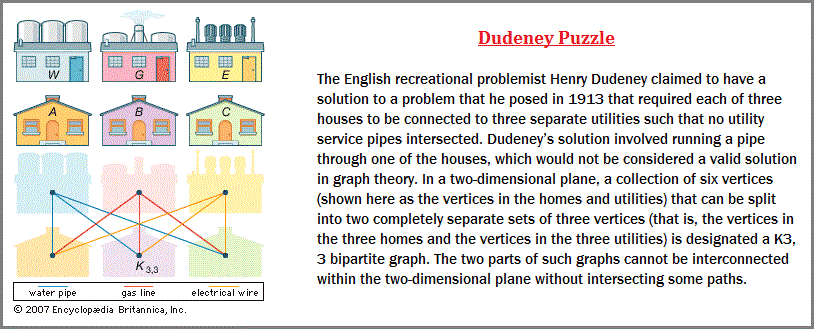
Here is the same type of puzzle in a slightly different arrangement, with the problem solved by thinking "outside the box", so to speak, with the box referring to the condition under which some people "attack" (concentrate on) the problem head-on as if there was no other way to solve the issue except by going straight to the intended target(s). The solution is to the right.
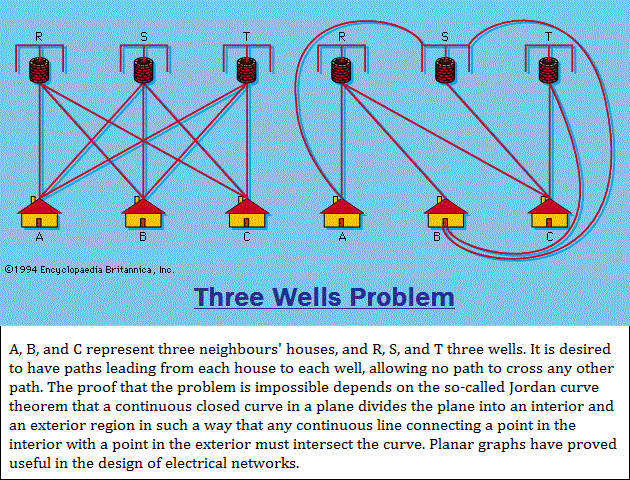
Source: "Number game." Encyclopædia Britannica Ultimate Reference Suite, 2013.
Please note that each is paired, though when paired with two others, the pairing sequence is placed into a secondary position of observation from the overall set-of-three. It is also of interest to point out how this 3,3,3 arrangement closely mimics the organizational pattern found in the old Norse idea concerning a World Tree; with its three branches, three roots, and three wells.
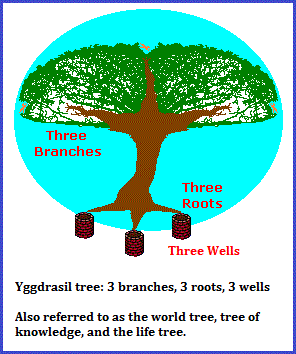
(Yggdrasil) in Norse mythology, (was) the world tree, a giant ash supporting the universe. One of its roots extended into Niflheim, the underworld; another into Jötunheim, land of the giants; and the third into Asgard, home of the gods. At its base were three wells: Urdarbrunnr (Well of Fate), from which the tree was watered by the Norns (the Fates); Hvergelmir (Roaring Kettle), in which dwelt Nidhogg, the monster that gnawed at the tree's roots; and Mímisbrunnr (Mimir's Well), source of wisdom, for the waters of which Odin sacrificed an eye. After Ragnarök (Doomsday), the world tree, though badly shaken, was to be the source of new life. Source: "Yggdrasil." Encyclopædia Britannica Ultimate Reference Suite, 2013. |
In the next image we see a bit of architecture using a pattern-of-three on top (like three branches) and a 3-tiered landscaping format (symbolizing a "route" [root]) as the central position, but no distinctive representation of 3 wells, unless one would care to dip into some metaphysical definition of men, women and children (unless) some other analogy is preferred.

In all the examples, including the foregoing 3-paired problems (puzzles), let us not overlook that there is a layering effect: 3 on 3 set in a paired configuration, with the images just below them representing a 3 on 3 on 3. The layering characteristic of these 2/3 situations is important because it is used in the construction of computer circuitry to establish a three-part configuration for the binary code arrangement:
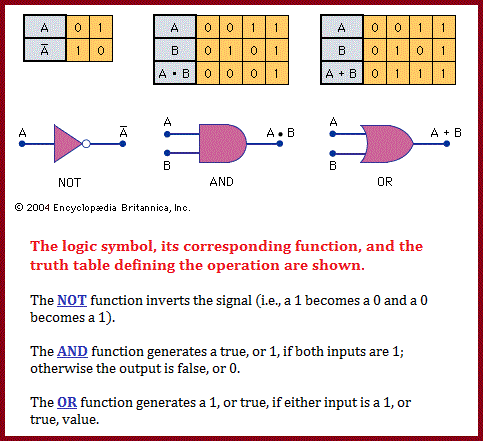
Whereas we can see the three quite easily when they are pointed out, an absence of distinction may go unnoticed except to more experienced observers. The same goes for the situation in basketball, where there is a uniform distinction as to what part of a court a three-point shot is valid; two point regular shots and one-point free-throw shots do not receive the same sort of demarcated representation. While many are aware of such invisible lines, and take them for granted, a person unfamiliar with the game would not be able to quickly deduce why and where different point values are assigned.
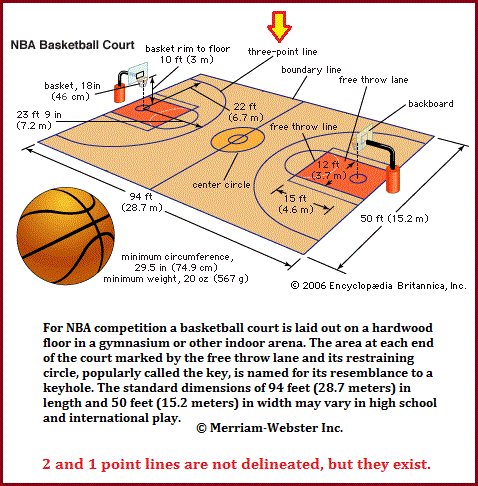
Again and again and again, we are seeing the same cognitive patterns and illustrations cropping up in different subject areas... but we must determine how the patterns are configured in our brains... when and how they start... and whether they are truly modified or merely take on different symbolism in different contexts. Is our cognition hierarchically arranged, or are we imposing such an idea on ourselves by taking images from the environment (trees, geology, water flow, weather patterns, etc.)? If such images can affect us mentally, there may be an environmental link between image formation and representation that we are taking for granted, and thus not adding it to our exercised equations. In many instances, a direct point for point comparison can not be made, but similarities do arise nonetheless. Take the following three images for example. It is interesting to note how a biological structure seems to be generally imitated in the man-made concepts. While many people may have seen similar images under separate contexts, their minds do not make a connection, probably because the images appear in divergent areas of study.
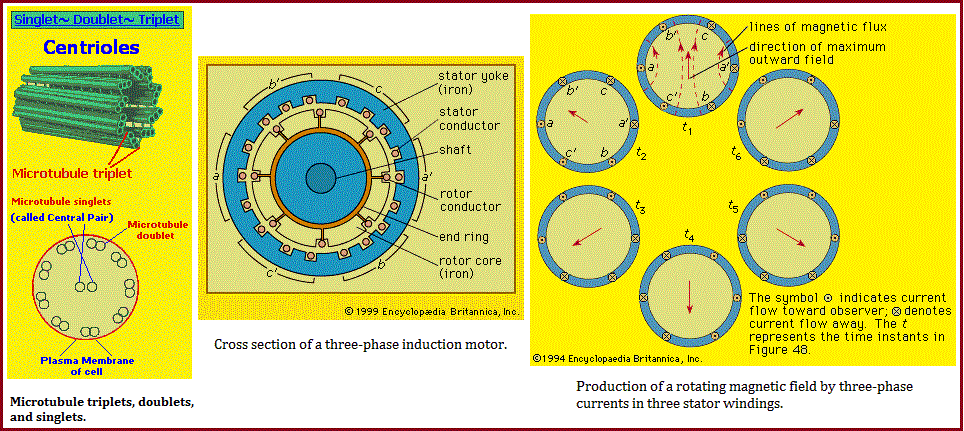
a system of filaments or fibres that is present in the cytoplasm of eukaryotic cells (cells containing a nucleus). The cytoskeleton organizes other constituents of the cell, maintains the cell's shape, and is responsible for the locomotion of the cell itself and the movement of the various organelles within it. The filaments that comprise the cytoskeleton are so small that their existence was only discovered because of the greater resolving power of the electron microscope. Three major types of filaments make up the cytoskeleton: actin filaments, microtubules, and intermediate filaments. Actin filaments occur in a cell in the form of meshworks or bundles of parallel fibres; they help determine the shape of the cell and also help it adhere to the substrate. The constantly changing arrays of actin filaments help move the cell and mediate specific activities within it, such as cell cleavage during mitosis. Microtubules are longer filaments that are constantly assembling and disassembling; they play a crucial role in moving the daughter chromosomes to the newly forming daughter cells during mitosis, and bundles of microtubules form the cilia and flagella found in protozoans and in the cells of some multicellular animals. Intermediate filaments, in contrast to actin filaments and microtubules, are very stable structures that form the true skeleton of the cell. They anchor the nucleus and position it within the cell, and they give the cell its elastic properties and its ability to withstand tension. Source: "Cytoskeleton." Encyclopædia Britannica Ultimate Reference Suite, 2013. |
While to some readers the foregoing compared images may be interpreted as superficial correlations, they nonetheless expose us to vagaries of the mind that we will have to contend with when instructing an AI on the width, depth and breadth of information gathering, association, deletion and analysis for a given context. The topic of imagery (and image processing) will no doubt play an important role in the structure of independent thinking AI compartmentalizations... since they now play a key role in creative thinking applied to different subjects... regardless if one person's defined creativity is another's defined mediocrity.
Image Processing Set of computational techniques for analyzing, enhancing, compressing, and reconstructing images. Its main components are importing, in which an image is captured through scanning or digital photography; analysis and manipulation of the image, accomplished using various specialized software applications; and output (e.g., to a printer or monitor). Image processing has extensive applications in many areas, including astronomy, medicine, industrial robotics, and remote sensing by satellites. Source: "Image processing." Encyclopædia Britannica Ultimate Reference Suite, 2013. |
|
Pattern Recognition In computer science, the imposition of identity on input data, such as speech, images, or a stream of text, by the recognition and delineation of patterns it contains and their relationships. Stages in pattern recognition may involve measurement of the object to identify distinguishing attributes, extraction of features for the defining attributes, and comparison with known patterns to determine a match or mismatch. Pattern recognition has extensive application in astronomy, medicine, robotics, and remote sensing by satellites. Source: "Pattern recognition." Encyclopædia Britannica Ultimate Reference Suite, 2013. |
Speech Recognition (Speech Recognition is) the ability of machines to respond to spoken commands. Speech recognition enables “hands-free” control of various electronic devices—a particular boon to many disabled persons—and the automatic creation of “print-ready” dictation. Among the earliest applications for speech recognition were automated telephone systems and medical dictation software. It is still frequently used for dictation, for querying databases, and for giving commands to computer-based systems, especially in professions that rely on specialized vocabularies. Before any machine can interpret speech, a microphone must translate the vibrations of a person's voice into a wavelike electrical signal. This signal in turn is converted by the system's hardware—for instance, a computer's sound card—into a digital signal. It is the digital signal that a speech recognition program analyzes in order to recognize separate phonemes, the basic building blocks of speech. The phonemes are then recombined into words. However, many words sound alike, and, in order to select the appropriate word, the program must rely on the context. Many programs establish context through trigram analysis, a method based on a database of frequent three-word clusters in which probabilities are assigned that any two words will be followed by a given third word. For example, if a speaker says “who am,” the next word will be recognized as the pronoun “I” rather than the similar-sounding but less likely “eye.” Nevertheless, human intervention is often needed to correct errors. Programs for recognizing a few isolated words, such as telephone voice-navigation systems, work for almost every user. On the other hand, continuous speech programs, such as dictation programs, must be trained to recognize an individual's speech patterns; training involves the user reading aloud samples of text. Today, with the growing power of personal computers, the accuracy of speech recognition has improved markedly. Error rates have been reduced to about 5 percent in vocabularies containing tens of thousands of words. Even greater accuracy is reached in limited vocabularies for specialized applications such as dictation of radiological diagnoses. Vladimir ZwassSource: "Speech recognition." Encyclopædia Britannica Ultimate Reference Suite, 2013. |
Subject page first Originated (saved into a folder): Thursday, November 13, 2014... 5:50 AM
Page re-Originated:Sunday, 24-Jan-2016... 08:51 AM
Initial Posting: Saturday, 13-Feb-2016... 10:59 AM
Updated Posting: Saturday, 31-March-2018... 3:09 PM
Herb O. Buckland
herbobuckland@hotmail.com